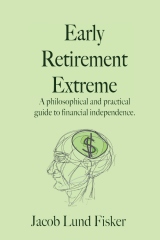Disclaimer: This post is aimed at beginners. If you already know your earnings yield from your free cash flow, I’m sure you can come up with something better on your own. I would strongly encourage anyone wishing to live of the rent of one’s money to take a strong interest in that money, but in the end it’s up to you.
The recommendation du jour, or since the trendy 1990s, for individual investors has been investing in low-fee broad market indexes. This recommendation is often picked because it is simple, but more importantly, I think, because it’s a great way to CYA for an adviser. In the past I have written about demographic risk, sustained trending risks, the risk due to underlying assumptions, and the risk of nondiversifying by diversifying like everybody else resulting in events like the flash crash. However, there’s another reason why I don’t like the typical buy&hold approach for extreme early retirement, though.
In a traditional retirement, you accumulate shares in an index. The value of those shares grow and fall with the stock market. Average people tend to discuss average returns without considering volatility. This is besides the point, but I just can’t help myself. More importantly, the idea in retirement then is that one starts selling shares in retirement until one runs out—hopefully dying before that happens.
To me that’s like living in a tree house saving off branches here and there hoping that the tree will survive until one “moves out”.
For extreme early retirement, I prefer not to sell shares to cover my living costs! Exclamation mark! Shares can be sold for other reasons, such as market reasons or business reasons, but they should nnot be sold for personal reasons. I therefore prefer to sustain myself with dividends.
When you live on dividends, fees can become quite important, because they are a substantial part of the payout. Suppose the fee is 0.4% and the yield is 3.2%. Then the fee is actually 12.5% of your expenses. That’s a lot!
The way to get around the fee is to build your own fund. Now, keeping the initial disclaimer in mind, if you don’t know anything, it is hard (except in 2008–2009) to go wrong with blue chips.
Hence, I recommend the Dogs of the Dow strategy in the same spirit as other pf-blogs recommend general broad market index funds. It may not be ideal, but if you don’t want to spend a great deal of time messing around with investing, it works pretty well. All you need to know is basic arithmetic.
The link above describes how to run it. In general, I use value averaging at 7% for the stock entire portion of the portfolio; I rebalance once a year; and I use an intermediate bond fund(*) like BND.
(*) The reason, I use a fund for bonds, is that contrary to stocks, institutions can negotiate better rates on bonds. Also bonds trade in much larger blocks. A bond order should be $50-100k per bond to get reasonable rates. I wouldn’t consider something smaller than $10k for a bond order. Consequently, it is hard to achieve diversification or even a ladder without $100-200k just for the bond portion. If then bond portion is just 20%, the total portfolio would be much larger than anything an ERE strategy would intend to achieve.
So this it how it works:
- Suppose you already have serious cash. By serious, I mean something like $10,000, but $20,000 is better. You then divide it into 10 equal portions and buy $2000 worth of each of the ten highest yielding Dow stocks. Suppose, one year later, you saved an additional $17000 (hey, you’re an ERE, right?) and the stocks are now worth $23,000. According to the value averaging scheme, your stocks should grow by 7%. This means that the stock portion should be worth 1.07*20000=21400. Buy and sell accordingly with the new goal of $2140/position. This takes about 10 minutes. You now have 17000 plus the 23000-21400=1600 so 18600 in cash. Buy BND with that. If in some years, you don’t have enough cash contributed, just sell off the BND fund.
- Suppose you don’t have any cash and you just started. In this case, I would simply buy $1000 worth of one position starting from the top every time I saved $1000. That is, start with Verizon. Next buy AT&T. Then Pfizer, and so on. After you got all ten, saved $2000 in reserve. Then start over, bringing all the positions to $2000. Each stock should be revisited about once a year. So if your $1000 Verizon position trades at $900 next year, buy $1100 worth of Verizon. If it trades at $1200, only buy $800. This method does not use value averaging, so it is not as predictable/projectable as the first method. It works well, if you’re employed and contributes regular amounts which are a sizable fraction of your net worth, i.e., you just started saving.
If a company has left the list, sell it and buy the replacement. To implement this, you need a broker account. Usually, but not always, brokers want an initial deposit, which is anything from $500 to $3000 or so.
The beauty of this portfolio strategy is that it produces an actual yield of [typically] 3-4%. This is real money, which you can use to pay and compare to your expenses rather than a somewhat abstract withdrawal rate.
Much thanks goes to MB for the donation.

